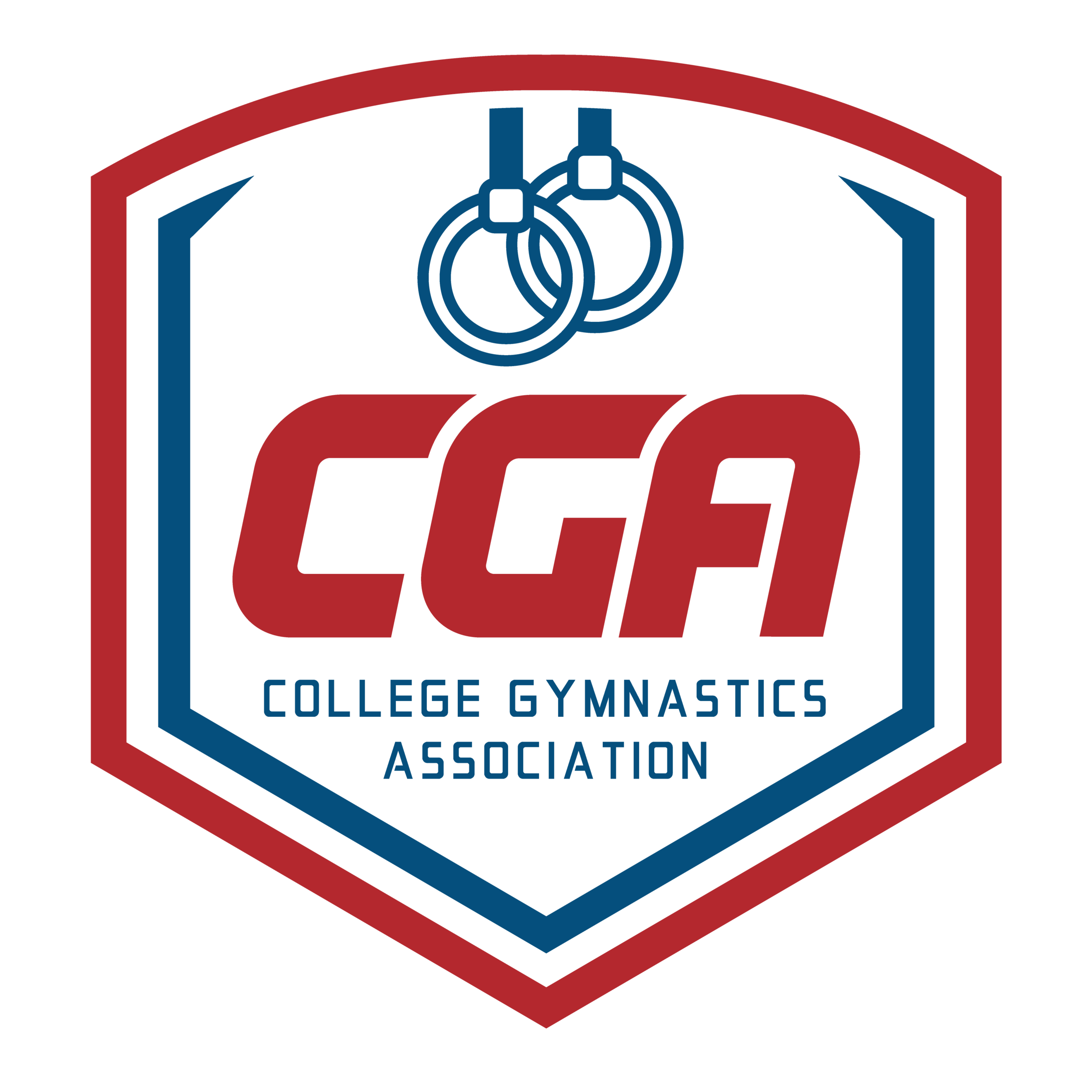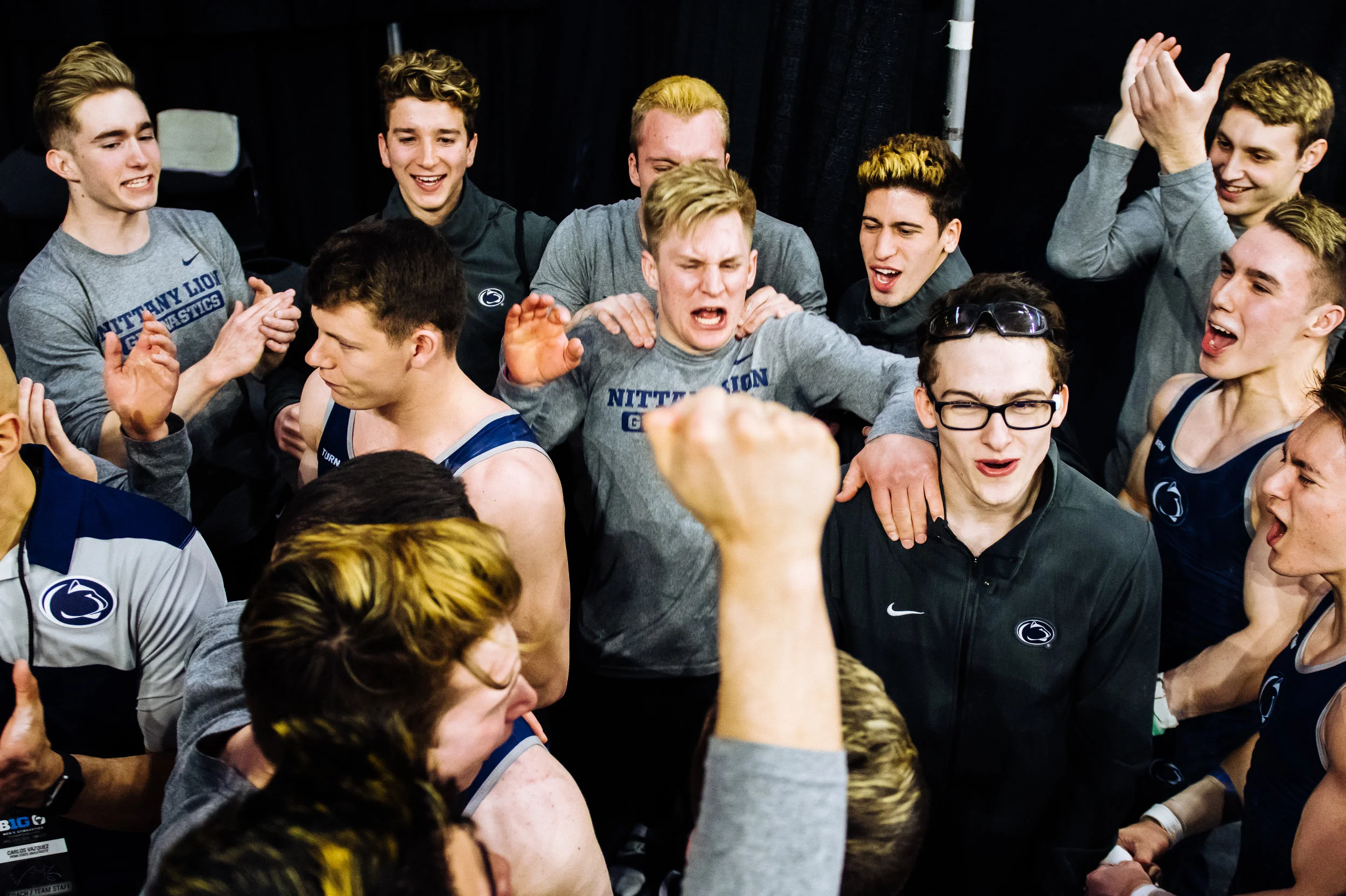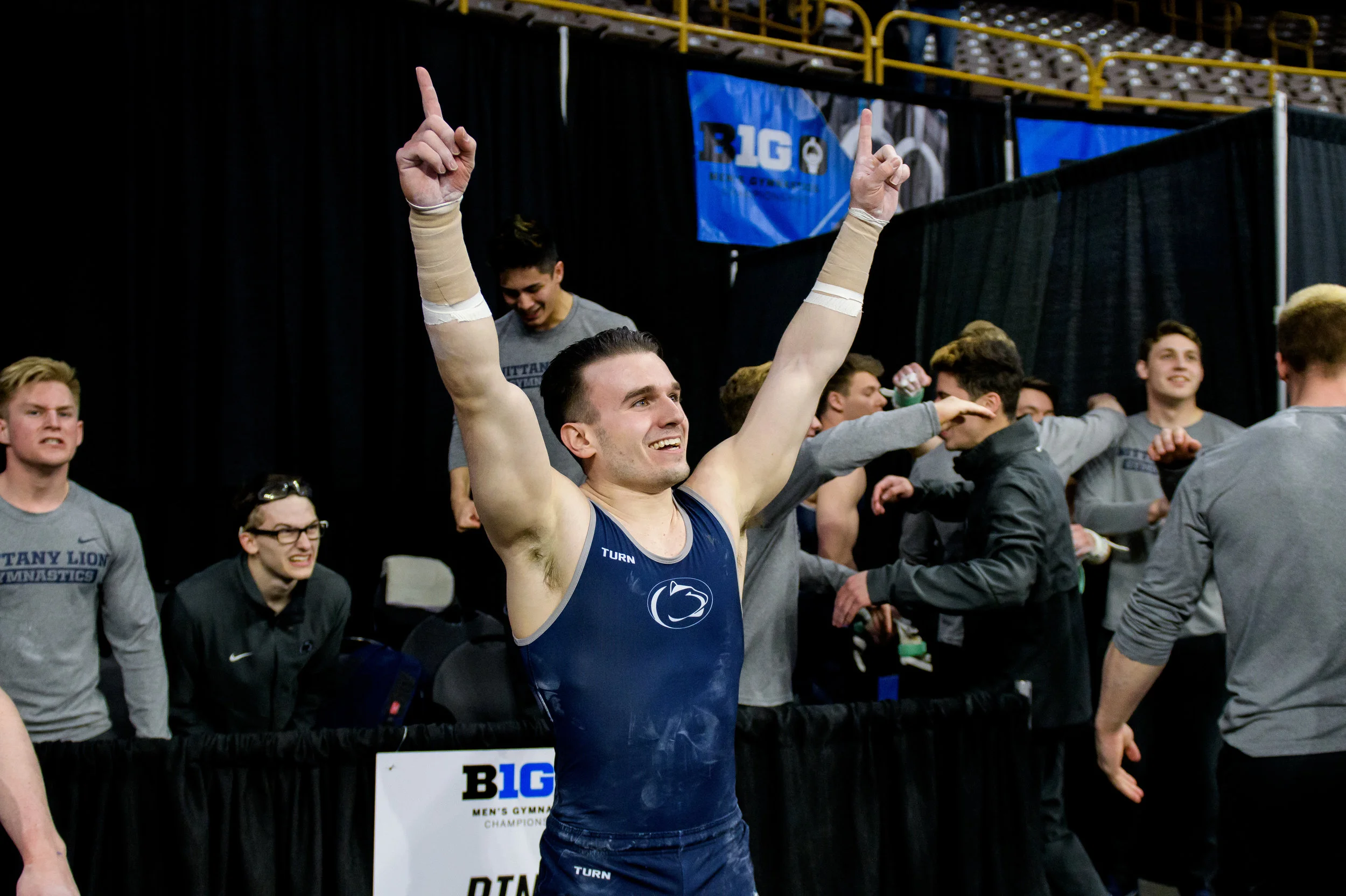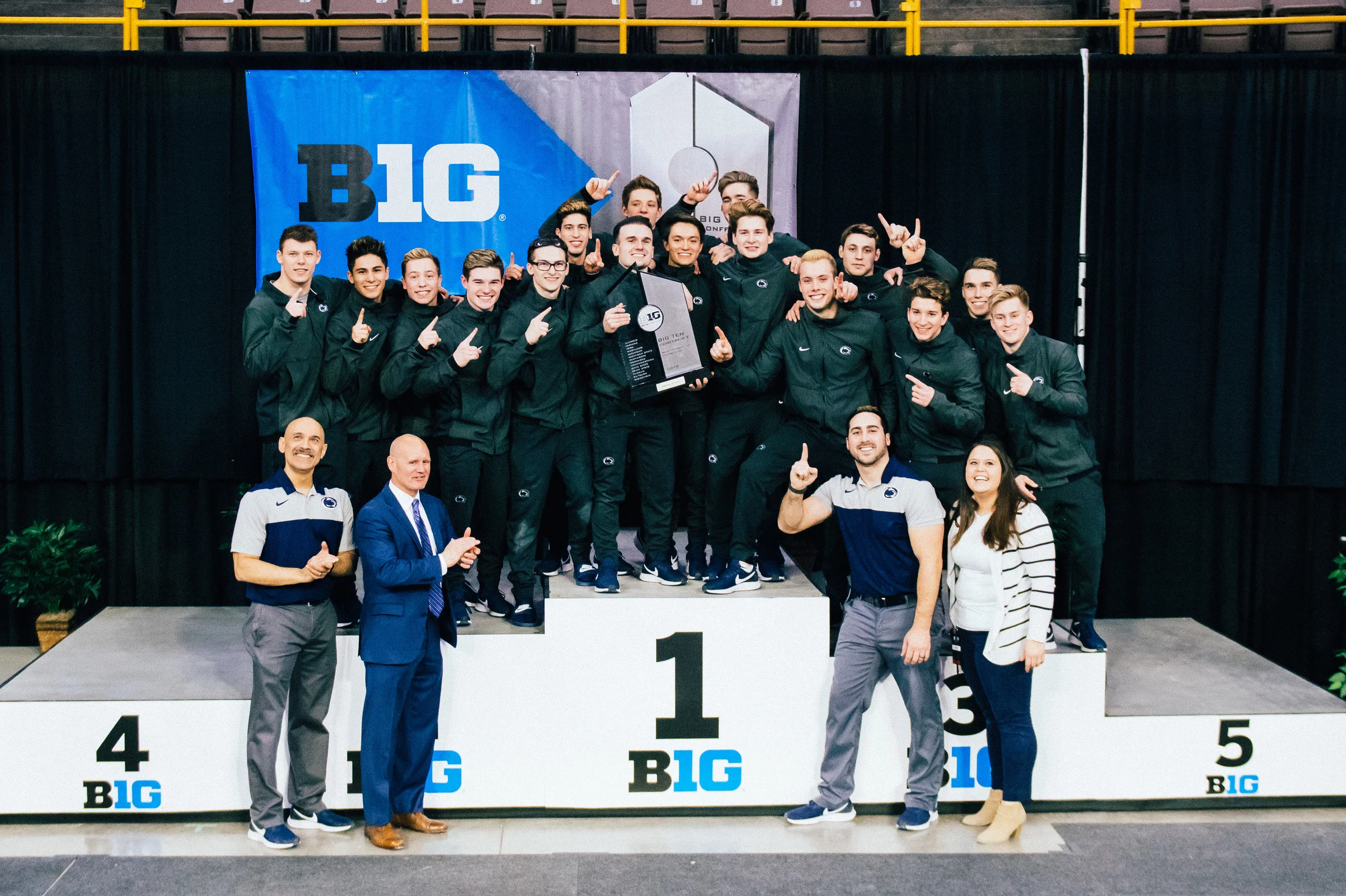2019 #NCAAMGym Conference Championships Recap
The dust has settled on Conference Championship weekend, and once all was said and done the Oklahoma Sooners (MPSF), Penn State Nittany Lions (B1G) and Navy Midshipmen (ECAC) came out victorious within their respective conferences. While two (OU and Navy) were the perceived favorites, Penn State was not, upsetting the likes of Illinois, Michigan and others in the final moments of competition.
Now let’s get into our breakdown of each meet and how all sixteen teams fared…
MPSF Championships
The last time the Oklahoma Sooners lost an MPSF Conference Championship, Yul Moldauer was just 14 years old — a mere blip on the radar of NCAA men’s gymnastics. Fast-forward eight years later and Moldauer is the driving force behind the Sooners’ eighth-straight conference title after a magnificent performance inside of McCasland Field House on Saturday afternoon. His 87.7 all-around tally was one of four individual titles (PH, SR, PB) that the senior would claim on the day.
Time after time, Moldauer (NCAA Gymnast of the Week) has come up with clutch performances for his team. Saturday was no exception given the fact that OU got off to an unusual start on floor with a 69.15 — their second-lowest score of 2019. While the rotation was disappointing, it was still capitalized by Gage Dyer’s meet-leading 14.65.
One rotation is nothing to base a meet off of, but from the casual fan’s perspective, maybe Stanford had a shot? Indeed they did, but Moldauer and co. kept the heat on all afternoon long, even in spite of a couple of errors we may not typically see from the Sooners.
In my eyes, there were two key turning points in the competition. The first one came on vault — an event where the Sooners have a gigantic leg up on any single team in the NCAA. What was a 2.5-point deficit quickly turned into a 6.05-point OU lead. Yes, that’s correct — an 8.55-point swing over one event. I’m looking at you, Levi Anderson.
The vault heard ‘round the world earned (yep, calling it that) a 15.25 and an eruption from the Oklahoma crowd. It also made its rounds on social media and, oh my, did it deserve to. It should also be noted that vault wasn’t the only event where Anderson excelled. His 84.05 all-around score tied Stanford’s Brody Malone in the non-Yul division.
Comfortable lead in hand, the Sooners would run into some trouble on parallel bars with Matt Wenske missing his hand on a peach half; Moldauer swiftly made up for that error. The senior’s parallel bars was my second turning point of the meet, leading into a high bar rotation that would conclude with a fitting Anderson stuck dismount.
“I am going to miss this place a lot,” Moldauer told SoonerSports.com. “I just want to say thank you to everyone that's been here over the years. We wouldn't have a place like this if it wasn't for everyone working so hard before us. Every single detail, everyone that cleans up the gym even the people who set it up, all the staff, I just want to say thank you. Thank you to everyone at OU who just makes the Field House literally the best place to compete in with the best fans."
A fitting end to the home career of one of the greatest gymnasts the NCAA will ever see. And while helping his team earn an eighth-consecutive conference title is tremendous, I have a feeling that the Colorado-native and his teammates are thirsty for a bit more.
Second place is second place, and I know moral victories aren’t fun for anyone, but the Stanford Cardinal’s runner-up finish at MPSF Championships is one that Thom Glielmi and co. should be proud of. Five rotations of 70.0 or higher is quite the feat considering, 1.) the hype going into this meet as it was Stanford and Oklahoma’s first meeting of 2019 and 2.) the venue.
Essentially, Stanford was exactly who we thought they were. A tremendous FX and PB team (they gained 3.9 [points] on the Sooners over these two events) and an average (all things considered) VT and PH team. I’d argue that nobody has the fire power to keep up with OU on vault, but it was especially tough for Stanford on Saturday considering the counting of a 13.55 and 13.5.
There’s no use being overly-negative about the Cardinal, however. Brody Malone, as mentioned earlier, tied the Oklahoma veteran, Anderson, in the all-around putting together an impressive 84.05. Such a gutsy performance on a pressure-packed stage should only make fans more excited to see how this young man’s career plays out.
Let’s not forget about Nissen-Emery finalist, Grant Breckenridge. The senior was rock-solid all afternoon long, earning an 83.05.
While there were no conference titles to be brought home, the Cardinal really has something powerful to keep in the back of their mind as they look toward NCAAs. It’s been quite a while since somebody gave the Sooners a run for their money and Stanford was able to do just that.
Cal finished the MPSF Championships in third with a score of 394.7. The Bears weren’t able to seriously challenge either Oklahoma or Stanford, who were more than 20 points ahead of them.
The Bears’ best two events of the day were floor and vault — their 68.6 and 69.5 on each were both above their season averages. Aaron Mah led the way for Cal on floor, scoring a 14.3 to place fifth. Darren Wong was close behind with a 14.1. Wong also put up a 14.15 on vault for the Bears’ top score on the event.
Other noteworthy performances for the Bears came from Caleb Rickard on high bar, whose 13.7 earned him ninth, and Mitchell Awisus’ 13.6 on parallel bars, which was good for tenth.
Cal will face Stanford, Michigan, Minnesota, Nebraska and Navy on day one of the NCAA Championships.
The Air Force Falcons’ (fourth place) season came to an end this past weekend as they finished as the first team out of NCAA qualifications. The good news: Lukas Texeira will move on as an individual with a great shot at All-American status on high bar.
The senior highlighted this Air Force team at MPSF championships, beating out a tough field to take the high bar title (14.80). Texeira now ranks second in the country heading into the final weekend of the season.
Ryan Girouard (FX), Christian Kalustian (FX, HB), Frankie Valentin (FX, PH, SR, VT), Scott McMurray (PH), Zach Polen (PB), Ethan Esval (PB) and Allen Shadan (PB) will all join Texeira as individual competitors in Champaign.
B1G Championships
After an unsteady regular season that culminated in a last place finish at a tri-meet in Minnesota, no one really knew what kind of Penn State team was going to show up at Big Ten Championships. Four years removed from their 2015 Big Ten title, the Nittany Lions came back to life to take the 2019 trophy in thrilling fashion.
Right off the bat this team looked like they had what it took to win. After breezing to a 70.55 on vault, they went to parallel bars — an event where they’ve been lackluster all year. Wyatt Tyndall changed that narrative putting up a 14.65 — good enough for the top score in the meet. Their 69.65 was their highest score of the season. Michael Burns and Sam Zakutney then led high bar, both putting up 13.7s.
After struggling a bit on floor, Penn State was still in striking distance heading into their two best events. They put together a tidy five-for-five pommel horse rotation, beginning with a hit set from Favian Valdez (13.35) and ending with a dominant 14.95 from Stephen Nedoroscik. They were just 2.95 points behind Illinois heading to rings while their opponent went to the low-scoring high bar.
Despite the Illini putting up five great high bar sets, Penn State countered with four scores above 14 on rings: Isaac Hammett (14.35), Noah Roberson (14.30), Brayden Borromeo (14.10) and Parker Clayton (14.05). Their performance was just enough to close the three-point gap and take the 2019 Big Ten Title by two-and-a-half tenths.
Very few people expected Penn State to win this meet. A strong upperclassmen presence in the lineup was the real edge that landed them on the podium. While most other teams across the Big Ten featured young teams, the Nittany Lions were led by a class of six seniors that willed their team to 28/30 hit routines. It was a true reminder that often leadership can be more important than talent.
The blue and white weekend continued into event finals with Zakutney taking home the Big Ten parallel bars title with his 14.325 routine. Roberson (14.725) also made some noise losing to the untouchable Alex Diab on rings by a mere two-and-a-half tenths.
The 2018 Big Ten Champions looked poised to defend their title despite limping into the 2019 Championships. The Illini (second place) were strong throughout this meet but were just barely unable to come out on top to reclaim the throne.
Illinois started off a bit shaky on floor but bounced back with their best pommel horse rotation of the year. Michael Paradise crushed another set and posted a meet high 15.10. Moving to rings, the Diab brothers paced their team with Alex going 14.60 and Max right behind him with a 14.30.
Vault was another highlight where the Illini scored a 71.15, good enough for second in the meet on that event. Michael Fletcher stuck his kaz full and a half to place second (14.65). The trouble began on parallel bars where Hamish Carter took a spill on his dismount on his first set of the year on that event.
The Great Britain native was able to bounce back with a 13.85 on high bar to place second in the meet. The other four Illini in line up on their final event did their job as well, but it wasn’t enough as they came up short of Penn State.
Missing out on a title by two-and-a-half tenths is always going to hurt, but Illinois’ performance, all-in-all, was very impressive. After graduating the likes of Bobby Baker, Tyson Bull and Brandon Ngai, they still find themselves as one of the top teams in the country just one year later. It is even more impressive considering this second place finish was without Clay Stephens.
Alex Diab took home his fourth Big Ten rings title in as many years, a remarkable feat for the senior. Carter also notched a victory on high bar in event finals, the first in his very young career.
With a strong regular season in the rearview, Michigan (third place) entered Big Tens this year as a favorite to win, something that hasn’t been said of the Maize and Blue since the Sam Mikulak years. When the dust settled, the Wolverines were third, but that doesn’t quite tell the whole story. In fact, there’s something brewing on the Michigan squad that is reminiscent of those earlier days of dominance. Take the dynamic of Cameron Bock, Jacob Moore and Emyre Cole, for example — the three very nearly swept the all-around podium. A day later, Michigan swept the podium on floor, with Moore, Cole and Kevin Penev earning medals. Michigan is a formidable squad that can make a serious challenge for the podium in Champaign next week, a somewhat disappointing third-place finish notwithstanding.
The Wolverines finished the team competition with a 409.55, bookended by a strong 69.25 on floor, which was the highest team score on the event by more than a point. Despite that performance, Michigan was narrowly overtaken by Penn State and Illinois, who scored 410.35 and 410.1, respectively.
The Wolverines were in reach of the title for most of the meet, but high bar, their second-to-last event, knocked them too far down, and they weren’t able to come back from the 10.8 they had to count. In addition to floor, Michigan had the highest team score on vault, thanks to Cole’s stuck Yurchenko 2.5. Bock walked away with the all-around gold, Moore the silver, and Cole was right behind the two in fourth.
Michigan advanced 13 routines to day two, and they earned individual medals for the aforesaid floor sweep, in which Moore earned gold and Penev and Cole tied for silver, and for Cole’s second-place vault finish. Mack Lasker also placed fifth on pommel horse.
The Wolverines are in a good position heading into NCAAs. Aside from high bar, they had a steady meet and showed they were highly competitive amid the pressure of a major competition. They’ll face Stanford, Minnesota, Nebraska, Navy and Cal on day one of the competition.
During Friday’s team final competition, Nebraska (fourth place) came out scorching hot. A 69.15 on PB would do just fine (and would end up No. 2 in the field) and they quickly moved over to HB where a 65.85 (No. 3) seemed to put them squarely in position to make a run at a championship. Evan Hymanson came up especially big on the prior event with this 14.4.
While immensely improved in 2019 as a team on those two events, the Huskers just haven’t had the same oomph on FX and VT as they had in 2018 — and this was one of the areas that hurt them. A sixth place 70.45 (on VT) is a bit deceiving when you consider they were just .35 out of third place, but it just goes to show that this team doesn’t have the ability to blow things out of the water on the event as they did last year.
Still, Nebraska came out of the weekend with yet another B1G champion — and it was someone you might be familiar with. Anton Stephenson capped off an unbelievable conference career with a third-consecutive vault championship and given that it wasn’t even his best performance (the bar is SO high as he sticks nearly every time), it just goes to show you how talented the senior is.
The other top finisher for Nebraska during Saturday’s event finals was the aforementioned Hymanson, who placed fourth on parallel bars.
After an awesome regular season that won them share of the regular season title, the championships were not as kind to the Golden Gophers. They finished in fifth place behind solid all-around performances from Shane Wiskus (81.55) and Justin Karstadt (81.30), who were both named First-Team All-Big Ten.
David Pochinka wrapped up his freshman year with solid performances on parallel bars (13.65) and high bar (13.55). Eric Nakamura took seventh place on floor in his Big Ten debut with a 14.00. The formidable Minnesota freshman class got some great big meet experience.
The Gophers will move on from Big Tens with an eye toward NCAAs where they will have to perform better to move on to day two once again.
Friday night was what can be described as an up-and-down day for the Ohio State Buckeyes (sixth place). While they blew things out of the water on pommel horse (No. 1 in the field with a 69.05), there was no way they were going to be able to dig themselves out of unfortunate showings on FX (64.0) and PB (66.25).
Still, PH is exactly why the Buckeyes should keep the faith moving into NCAAs. Not a single gymnast scored below a 13 — that’s not something to be taken lightly given the big stage and pressure of postseason pommel horse. Trevor Cummings stepped up huge with a 14.25 while their team leader and centerpiece, senior Alec Yoder, led the way with a 15.05.
That number, of course, qualified Yoder into the event finals where he rose above two phenomenal pommel horse workers to secure yet another B1G PH title for himself:
B1G has been living in the golden age of pommel horse for the last handful of years, and Alec Yoder has played a big part in me being able to describe it that way. Yoder also finished as the runner-up on parallel bars while Sean Neighbarger was right up there in a tightly-packed vault field with a fourth place finish.
Iowa was lauded throughout the season for their ability to perform clean gymnastics consistently. But the wheels came off at Big Tens as the Hawkeyes, who ended the regular season with a share of the Big Ten title, fell to a disappointing seventh place.
Iowa’s problems began right from the start. Their first guy up on pommel horse fell, and they weren’t able to stanch the bleeding from there, ending the rotation with a 63.5, which was the lowest horse score of the meet. They seemed to be back on track after a solid rings rotation, but uncharacteristic mistakes returned on vault, where they were again the lowest-scoring team.
That was really the story throughout the meet. Iowa had so much success during the regular season because of their steady performances. And while high D-score gymnastics is risky by nature, so too is banking on always hitting your modest-to-low D-score routines. Iowa wasn’t able to do that at Big Tens, and their score suffered as a result.
That said, there were highlights for the Hawkeyes. Chief among them was Andrew Herrador’s second-place finish on high bar. Herrador finished day one in first and was narrowly edged out by Illinois’ Carter. Still, Herrador has had quite a season and his second-place finish was no fluke.
Another standout performance came from freshman Stewart Brown, who earned bronze on vault with a very clean Kaz 1.5. Jake Brodarzon was also just off the podium after putting up a 14.3 on rings, which was good for fourth.
Iowa will have their work cut out for them at NCAAs, where they’ll face Oklahoma, Illinois, Penn State, Ohio State and Army in prelims.
ECAC Championships
Navy posted a 10-point win to capture the ECAC Conference title and punch their ticket to the NCAA Championships in Champaign, building on the momentum they’ve cultivated this season. The Midshipmen scored a 401.15 to defeat rival Army, who put up a 390.65, as well as William & Mary, Springfield and UIC. It was the third-consecutive meet in which Navy scored above 400.
Navy had the top team score on five events and earned four individual titles. Most noteworthy among their event wins was pommel horse, where their 68.15 was an almost five-point improvement upon their performance on the event last week.
Earning individual titles for the Midshipmen were David Toussaint on pommels, Josh Williams on rings, Lucas Beltran on vault and Ben Provost on high bar. Earning silvers for Navy were Frank Bradley and Beltran on floor, Ryan Orce on pommel and rings, and Cash Buske on high bar.
Navy did give up a few points on parallel bars and high bar, however. They dropped by about two points on each event from USAGs. Navy was able to make up for the difference with strong performances on the other four, but the Midshipmen would do well to get back those four points at NCAAs next Friday.
Navy will face Stanford, Michigan, Minnesota, Nebraska and Cal on day one of NCAAs in Champaign.
The Black Knights took a second place finish at ECAC Championships, but more importantly, they punched their ticket to NCAAs - their first time since 2007.
Mathew Davis was the driving force behind their runner up finish, notching a 79.05 in the all-around to put him in second place. He also had first place finishes on floor (14.40) and parallel bars (13.15). Army had another event winner in Elliott Herman who took a share of the rings title (13.85).
The freshman-senior duo of Davis and Cole Casanova has breathed new life into this team. Their trip to Champaign, Illinois is well deserved as they have been an awesome team to watch all season.
William & Mary earned a third-place finish at last weekend’s ECAC Championships, scoring a 388.55 to edge out Springfield College and UIC.
The best two events for William & Mary were rings and vault. Their 65.2 on rings was fewer than four tenths away from the top score on the event, and their 68.85 on vault was fewer than two tenths away from the top score. David Watkins helped William & Mary get there on rings; he scored a 13.85 to tie for the gold. On vault, Tim O’Neil placed third with a 14.15.
Other highlights for William & Mary included Cutter Fugett’s fourth-place finish on floor, Jacopo Gliozzi’s third-place finish on pommels and David Allen’s second-place finish on high bar.
The Tribe advanced 11 individual gymnasts to the NCAA Championships next weekend, a school record. Allen will compete on high bar, Fugett on floor and pommel horse, Gliozzi on pommel horse and rings, Jack Hasenkopf on vault, Collin Lillie on floor and vault, Andrew Lyubovsky on parallel bars and high bar, O’Neil on vault, Kevin Portofee in the all-around, Spencer Schrandt on pommels, Watkins on rings and Nate Winneg in the all-around.
The fourth-place finish won’t reflect it correctly, but the Springfield Pride did themselves…proud (very, very bad pun)…at ECAC Championships. In all seriousness, the Pride came up with their second-highest team score of 2019, and there was no better time to do it as they were competing at home in front of all their fans. On the day, they put together two (FX and PH) event totals that were season-highs.
While no individual accomplishment should overshadow a team as a whole, I’d be remiss not to mention the historic performance of junior Stephen Lewis. Heading into Saturday, he was hardly the favorite to win the all-around given how well Army’s big two have been this season. No matter for Lewis, however, as he became the first Springfield gymnast EVER to win two ECAC all-around titles. Oh, by the way, those were in back-to-back seasons. Despite him still having a season remaining, I’m confident in calling Lewis one of the best gymnasts that the Pride has ever had. In reality, by the end of next season, he may be hands down the best ever.
In our conference preview, we pointed to freshman Paul Burney as a key gymnast for UIC — a lot of pressure for a rookie, sure, but it was true. After Saturday, not to say I told you so, but…I told you so. On the biggest stage, Burney stepped up for his team and led the way on two events — VT and HB.
Burney was far from the only gymnast who helped the Flames to a season-high team score (by over three points!). The all-around duo of Sam Montague (76.6) and Xan Weaver (74.85) came through in big ways. They’ll both have another huge opportunity in 2019 as they’ll travel to Champaign, IL to compete as all-arounders at NCAAs.
All-in-all, freshmen had the top score on four of six events for UIC with Kaleb Booth (along with teammate Sam Montague) leading on FX as well as Nick Smiley on PB.
What a fantastic finish to this season it was for the UIC Flames. It’s impossible to understand what each and every one of those gymnasts went through this season so a big hats off to them.







